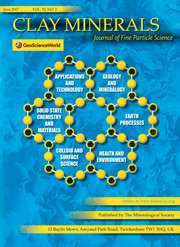Article contents
Mineralogical transformations accompanying the chemical weathering of clay-slates from New South Wales
Published online by Cambridge University Press: 14 March 2018
Abstract
A study has been made of the mineralogical transformations that have accompanied the chemical weathering of some Palaeozoic clay-slates from New South Wales. The weathered sequences occur within a limited range of climatic and topographical conditions. Chlorite, interlayered with other expanded-lattice silicate minerals, is the least chemically stable of the primary constituents. Montmorillonite is a little more resistant to the percolating waters, whereas illite, present in all primary materials as the 2M1 polymorph, is relatively chemically stable. In the zone of maximum leaching, however, partial degradation and loss of illite is apparent. Kaolinite is the end-product of the breakdown of these clay minerals.
- Type
- Research Article
- Information
- Copyright
- Copyright © The Mineralogical Society of Great Britain and Ireland 1964
References
- 2
- Cited by


